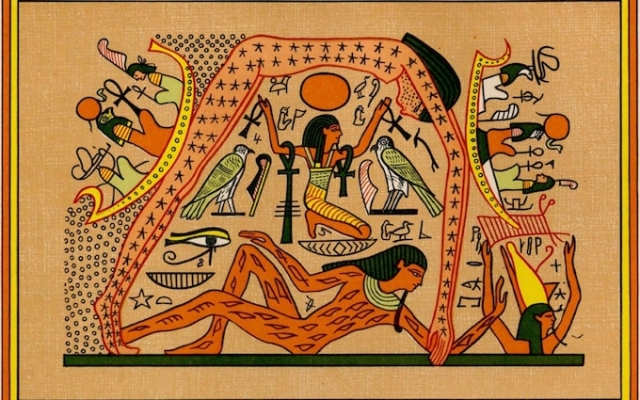 The sky goddess Nut is depicted covered with stars and arched above the world — similar to the Milky Way. Photo: E. A. Wallis Budge, «The Gods» of the Egyptians, Vol. 2 (Methuen & Co., 1904)
The sky goddess Nut is depicted covered with stars and arched above the world — similar to the Milky Way. Photo: E. A. Wallis Budge, «The Gods» of the Egyptians, Vol. 2 (Methuen & Co., 1904)
The ancient Egyptian sky goddess Nut is usually depicted as a woman adorned with stars, arching her body high above the Earth.
Scientists now believe that Nut, pronounced » Triton,” perhaps a depiction of the Milky Way, which hung in the sky like a white rainbow when ancient myths were born.
Or Graur, associate professor of astrophysics at the University of Portsmouth, combined astronomical models of the ancient Egyptian sky and compared them with descriptions and images of the goddess.
Dr Graur discovered that the summer and winter orientation of the Milky Way coincided with the body of Nut. In winter, the Milky Way illuminated Nut's outstretched arms, and in summer, her spine across the sky.
 The Milky Way curving over the Black Desert in Egypt. Photo: mediadrumimages/BenjaminBarakat
The Milky Way curving over the Black Desert in Egypt. Photo: mediadrumimages/BenjaminBarakat
“I accidentally met the sky goddess Nut while I was writing a book about galaxies and studying the mythology of the Milky Way,” said Dr. Graur.
“I took my daughters to the museum and they were fascinated by this image of a curved woman and constantly asked to hear stories about her.
“This piqued my interest and I decided to combine astronomy and Egyptology to do a dual analysis — astronomical and cross-cultural — of the sky goddess Nut and whether she could really be connected to the Milky Way «.
Nut was the goddess not only of the sky, but also of the stars, space, mothers and astronomy.
They say that with her head to the west and her feet to the east, Nut absorbed the Sun at night and gave birth to him every morning.
 Nut was not only the goddess of the sky, but also the stars, space, mothers and astronomy. Photo: Science History Images/Alamy Stock Photo
Nut was not only the goddess of the sky, but also the stars, space, mothers and astronomy. Photo: Science History Images/Alamy Stock Photo
In ancient Egyptian mythology, she was married to Geb, the god of the Earth and was originally only a goddess of the night sky.
She appears frequently in the Book of Nut, one of the world's first astronomical texts, which recorded the cycles of the stars and planets and dates back to at least 2000 BC.
Dr. Graur was also able to connect Nut with other myths related to the Milky Way, sky goddesses and celestial bodies.
The Codex Borgia, a 16th-century Mexican manuscript, depicts elongated beings covered in stars, believed to represent the Milky Way and the goddess. Citlalicue is the goddess of the stars.
In Africa, several tribes call the Milky Way the “spine of the night,” and in North America, the people of Tewa, Taos and Jemez Pueblos call it the “spine of the Universe.”
 The Milky Way is seen as the basis of the universe in many ancient cultures. Photo: mediadrumimages/BenjaminBarakat
The Milky Way is seen as the basis of the universe in many ancient cultures. Photo: mediadrumimages/BenjaminBarakat
Dr Graur added: “My research also shows that the role of chickpea in the passage of the deceased to the afterlife and its connection with the annual migration of birds is consistent with how the Milky Way is understood in other cultures.
“For example, like the path of spirits among different peoples of the North and Central America, or the “Bird Trail” in Finland and the Baltic countries.
“My research shows how combining disciplines can offer new understanding of ancient beliefs, and highlight how astronomy unites humanity across cultures, geography and time. «.
The work was published in the Journal of Astronomical History and Heritage.




















































Свежие комментарии